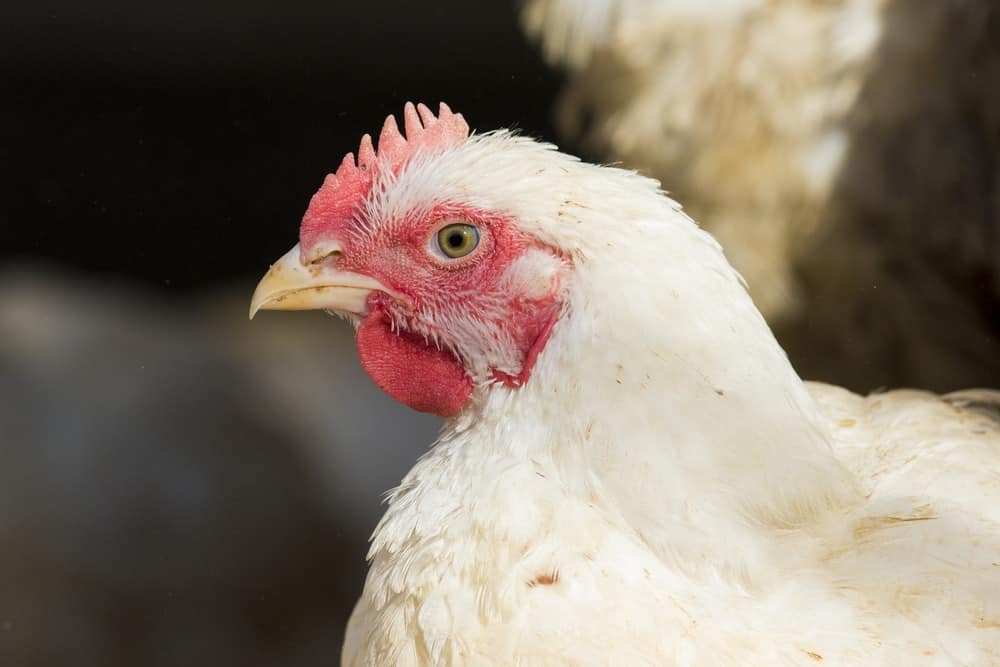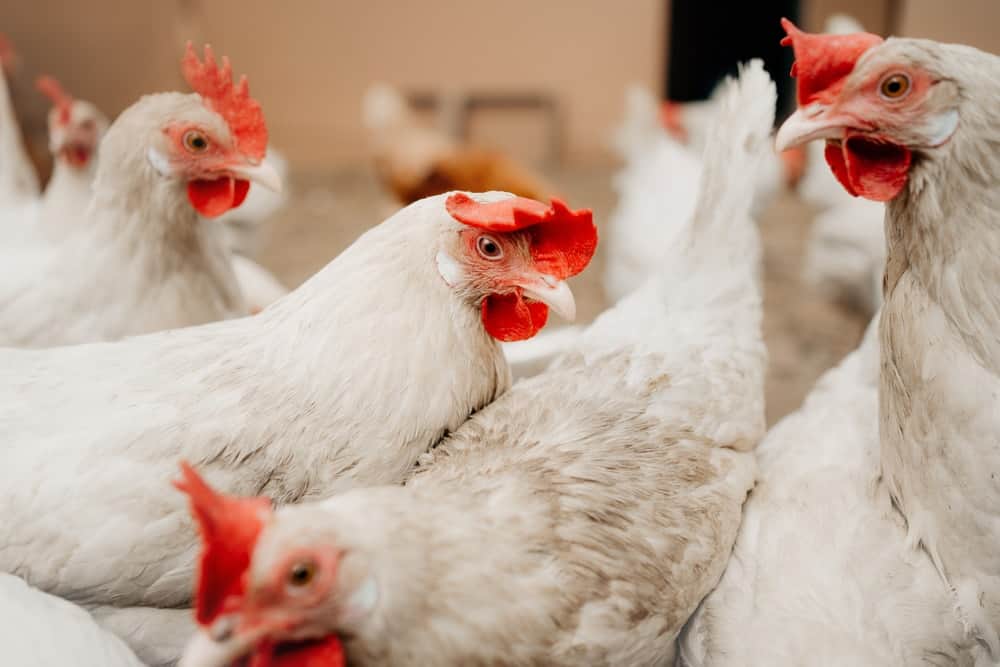If you regularly purchase chicken in your local grocery store, chances are you are already familiar with the Cornish Cross on a certain, fine dining, level. The development of this hybrid chicken was one of the most important revolutions in the growth of the commercial poultry industry. In this article, we’ll tell you about the traits, relevant information, and care needs of the Cornish Cross chicken breed. We’ll also discuss whether this breed is as good of an investment for small-scale farmers as it is for the industrial meat industry.

Quick Facts About The Cornish Cross (Cornish Rock)
| Breed Name: | Cornish Cross, Cornish Rock |
| Place of Origin: | United States |
| Uses: | Meat |
| Rooster (Male) Size: | 10 pounds |
| Hen (Female) Size: | 8 pounds |
| Color: | White, sometimes with dark specks |
| Lifespan: | 18 months at most, usually butchered at 8–10 weeks |
| Climate Tolerance: | Poor |
| Care Level: | Hard |
| Production: | 3–4 pounds of meat/bird |
Cornish Cross (Cornish Rock) Origins
The Cornish Cross is a hybrid chicken breed, developed by crossing the Cornish and White Plymouth Rock chickens. The development of the Cornish Cross began in the mid-20th century, not long after the two parent breeds were identified as the top meat chickens in the United States, thanks to a contest sponsored by the Department of Agriculture. Selective breeding over the years has resulted in several different commercial genetic strains of Cornish Cross, which differ slightly in appearance. One of these strains is commonly called the Cornish Rock. The development of this breed helped chicken meat become more affordable, however, they are somewhat controversial due to the circumstances and reasoning behind its development.


Cornish Cross (Cornish Rock) Characteristics
Physical Development
The Cornish Cross was developed exclusively to be a fast-growing, cost-effective meat chicken. Because they were selectively bred for certain characteristics, such as heavy bodies and quick growth, some other traits fell by the wayside. For example, these birds are docile but not the brightest.
Cornish Cross chickens are not very hardy. They don’t tolerate hot or cold temperatures well and will need heat support if raised in chillier climates. The breed also doesn’t do well at altitudes above 5,000 feet.
Because they’re bred to be processed by 10 weeks of age, the Corning Cross may develop health issues if they live much longer. They quite literally get too heavy to support their own weight and can also have heart problems.
Feeding
Cornish Cross chickens are not a hands-off breed to raise. They are not good foragers and won’t put on weight at their usual pace without eating high-protein chicken feed. Because they are slow and not very bright, Cornish Cross chickens are especially vulnerable to predators and can’t be kept free-range.
These birds can’t be allowed constant access to food because they won’t self-regulate their intake and will make themselves sick. They also produce large quantities of extra smelly poop because they eat so much protein. Because they must be kept in an enclosure, you’ll spend more time cleaning up after the Cornish Cross than other breeds.
Breeding
As a hybrid breed, the Cornish Cross can’t reproduce safely. They are poor layers, typically sent to the processing plant before they are old enough to start laying eggs anyway.
Uses
The Cornish Cross is a meat bird, plain and simple. They were developed for that purpose, and they excel at it. The breed grows faster and is ready to eat in half the time as most other chicken varieties. Because they are not useful for egg production or hatching chicks for sale, the Corning Cross are single income-source birds.
Appearance & Varieties
All strains of Cornish Cross look relatively similar with only slight variations. The birds are white, with yellow legs, yellow skin, and a single red comb. Some strains may have some dark speckling to their feathers. Overall, they are heavy birds with large breasts and thighs. Depending on the specific genetic strain, a Cornish Cross may have over-developed breasts or more evenly spaced meat distribution. Males are generally slightly larger than females, who take a little longer to reach their ideal processing weight.

Population
The Cornish Cross is one of the most commonly utilized breeds for meat production. They are especially popular for industrial or commercial meat production because of their rapid growth rates. In other parts of the world, the Cornish Cross is often known simply as a broiler chicken and is sold under that name.
Are Cornish Cross (Cornish Rock) Chickens Good for Small-Scale Farming?
The Cornish Cross presents a bit of a riddle for the small-scale farmer. On one hand, they provide a rapid and efficient source of meat, allowing the homesteader to fill their freezer with home-raised chicken quickly or make some quick cash selling it. Points against them include their poor egg-laying ability and more intensive care level when compared to other chicken breeds. The Cornish Cross is also unable to self-populate because they are hybrids, meaning small-scale farmers will have to plan on purchasing more chicks rather than raising their own.

Conclusion
As we’ve learned, the Cornish Cross is a fantastic meat-producing bird that nonetheless presents both pros and cons to anyone considering raising them, especially small farmers. While their value to the poultry industry is unquestioned, this breed also has a reputation for being more trouble to care for than many other heritage chickens. As with any pet or livestock purchase, make sure you research the Cornish Cross carefully before deciding that they’re your bird of choice as a small-scale farmer.
Featured Image Credit: Ksenia Raykova, Shutterstock
